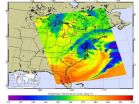Biologists produce rainbow-colored algae
2013-03-08
(Press-News.org) What can green algae do for science if they weren't, well, green?
That's the question biologists at UC San Diego sought to answer when they engineered a green alga used commonly in laboratories, Chlamydomonas reinhardtii, into a rainbow of different colors by producing six different colored fluorescent proteins in the algae cells.
While fluorescent green, red, blue and yellow may be all the rage this year for running shoes and other kinds of sporting gear, fluorescent algae hasn't been a style trend yet in scientific laboratories. But in announcing their achievement in the current issue of the Plant Journal, the UC San Diego biologists said tagging algae with different kinds of fluorescent proteins would provide an important laboratory tool for algae researchers. It could be used to sort different kinds of cells, allow scientists to view cellular structures like the cytoskeleton and flagella, or even to create "fusion proteins," allowing scientists to follow a protein around the cell.
Although rainbow colored algae are not likely to end up in a store near you any time soon, the scientists say they are powerful tools that will allow biologists working on algae to make biotechnology developments more rapidly, ultimately leading to the production of lower-cost biofuels and cheaper human and animal therapeutics. Several months ago, biologists in the same UC San Diego laboratory reported genetically engineering Chlamydomonas algae to produce a complex and expensive human therapeutic drug used to treat cancer.
The rainbow-colored algae were developed by a collaboration that included scientists from the University of Nebraska, Lincoln. Beth Rasala, a postdoctoral fellow in Mayfield's laboratory, is the lead author of the Plant Journal paper. The research was funded by the U.S. Department of Energy and the California Energy Commission.
INFORMATION:
ELSE PRESS RELEASES FROM THIS DATE:
2013-03-08
WACO, Texas (March 7, 2013) - A genetic analysis by Baylor University biologists suggests that the stocking of Florida bass in Texas reservoirs impacts bass populations far beyond the actual stocking location.
The native largemouth bass has a long and nearly continuous stocking history in Texas. However, the Florida bass is widely considered a better sport fish because it grows to a greater size. Subsequently, stocking efforts in Texas reservoirs have transitioned from largemouth bass to Florida bass.
The Baylor researchers analyzed the genetic composition of 69 largemouth ...
2013-03-08
Malaria, the leading cause of death among children in Africa, could be eliminated if three-fourths of the population used insecticide-treated bed nets, according to a new study from the National Institute for Mathematical and Biological Synthesis (NIMBioS).
The study, which uses a mathematical model, found that use of insecticide-treated bed nets or ITNs positively affected the infection's reproduction number, or R, which is the primary epidemiological number used to determine the degree which a disease can spread through a population. The model concludes that if 75 percent ...
2013-03-08
VIDEO:
This animation of NOAA GOES-13 satellite imagery from March 5-7, 2013, shows the progression of a cold front from the west associated with a low pressure system that brought snow...
Click here for more information.
The merging of two low pressure areas into a large Nor'easter on March 6 brought winter weather advisories and warnings to the Mid-Atlantic. NASA's Aqua satellite captured an infrared and near infrared image of the storm's power, and NASA created an animation ...
2013-03-08
The star Eta Carinae is ready to blow. 170 years ago, this 100-solar-mass object belched out several suns' worth of gas in an eruption that made it the second-brightest star after Sirius. That was just a precursor to the main event, since it will eventually go supernova.
Supernova explosions of massive stars are common in spiral galaxies like the Milky Way, where new stars are forming all the time. They are almost never seen in elliptical galaxies where star formation has nearly ceased. As a result, astronomers were surprised to find a young-looking supernova in an old ...
2013-03-08
With data from 73 ice and sediment core monitoring sites around the world, scientists have reconstructed Earth's temperature history back to the end of the last Ice Age.
The analysis reveals that the planet today is warmer than it's been during 70 to 80 percent of the last 11,300 years.
Results of the study, by researchers at Oregon State University (OSU) and Harvard University, are published this week in a paper in the journal Science.
Lead paper author Shaun Marcott of OSU says that previous research on past global temperature change has largely focused on the ...
2013-03-08
HOUSTON – (March 7, 2013) – Results of a study using several imaging methods showed that CCSVI (chronic cerebrospinal venous insufficiency) occurs at a low rate in both people with multiple sclerosis (MS) and non-MS volunteers, contrary to some previous studies. The research by an interdisciplinary team at The University of Texas Health Science Center at Houston (UTHealth) was published in a recent early online edition of the Annals of Neurology.
"Our results in this phase of the study suggest that findings in the major veins that drain the brain consistent with CCSVI ...
2013-03-08
A new report from the Wildlife Conservation Society Canada (WCS Canada) creates a conservation strategy that will promote wildlife resiliency in the Southern Canadian Rockies to the future impacts of climate change and road use. The report's "safe passages and safe havens" were informed in part by an assessment of six iconic species—bull trout, westslope cutthroat trout, grizzly bears, wolverines, mountain goats and bighorn sheep—five of which were ranked as highly vulnerable to projected changes.
Nestled between Glacier National Park in Montana and Banff National ...
2013-03-08
In the movie Alien, the title character is an extraterrestrial creature that can survive brutal heat and resist the effects of toxins.
In real life, organisms with similar traits exist, such as the "extremophile" red alga Galdieria sulphuraria.
In hot springs in Yellowstone National Park, Galdieria uses energy from the sun to produce sugars through photosynthesis.
In the darkness of old mineshafts in drainage as caustic as battery acid, it feeds on bacteria and survives high concentrations of arsenic and heavy metals.
How has a one-celled alga acquired such ...
2013-03-08
Scientists at UC San Francisco have found a more precise way to turn off genes, a finding that will speed research discoveries and biotech advances and may eventually prove useful in reprogramming cells to regenerate organs and tissues.
The strategy borrows from the molecular toolbox of bacteria, using a protein employed by microbes to fight off viruses, according to the researchers, who describe the technique in the current issue of Cell.
Turning off genes is a major goal of treatments that target cancer and other diseases. In addition, the ability to turn genes off ...
2013-03-08
To students in Jennifer Burg's computer science classes, making music is the main objective. But her goal is to get them to understand how the underlying technology works – and to love it so much they decide on a science-based career path.
And that, Burg's study has shown, has helped Wake Forest University fulfill the national imperative to increase the number of majors in the STEM disciplines of science, technology, engineering and math.
The results of Burg's research, "Computer Science 'Big Ideas' Play Well in Digital Sound and Music," will be published during the ...
LAST 30 PRESS RELEASES:
[Press-News.org] Biologists produce rainbow-colored algae




